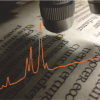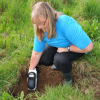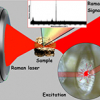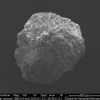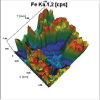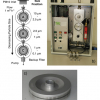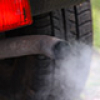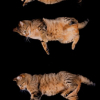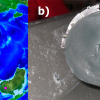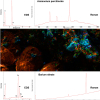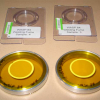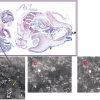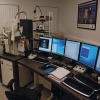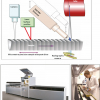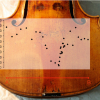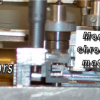Articles
It is not every issue that one of our articles starts with a quotation in medieval English, and it is appropriate as two of our articles cover the use of spectroscopy in cultural heritage. This is yet another field where the rich information provided by spectroscopy, along with its non-destructive nature (for many techniques), portability and ability to generate chemical images make it the answer to many questions. Kate Nicholson, Andrew Beeby and Richard Gameson are responsible for the medieval English at the start of their article “Shedding light on medieval manuscripts”. They describe the general use of Raman spectroscopy for the analysis of historical artefacts, and, in particular, their work on medieval European manuscripts and 18th century watercolour pigments. They stess the importance of checking the actual laser power density to avoid damage to priceless artefacts.
Once again developments in portable instruments lead to greater ease of use and the ability to measure far more samples. They describe the application of FT-IR, NIR and XRF spectroscopies to the development of the National Soils Inventory of Scotland, and their work in developing the use of handheld instruments, particularly FT-IR spectrometers.
This article looks at the use of Raman and XRF spectroscopies to investigate the different deterioration processes caused by marine aerosols. These techniques can detect the decay compounds and the original composition of the different materials from historical buildings close to the sea, which can then be used to explain the reactions that take place on them. This helps in the development of remedial actions and preventive conservation strategies for historical buildings.
Several earthworm species secrete very small granules of calcium carbonate, and the authors think these are involved in pH regulation. These granules contain different polymorphs of calcium carbonate, including the amorphous form which is very unstable in the laboratory. To investigate this they have FT-IR spectroscopy and mapping, and are continuing this work with Ca XANES.
Yvonne Fors, Håkan Grudd, Anders Rindby and Lennart Bornmalm tell us about “X-ray fluorescence for cultural heritage: scanning biochemical fingerprints in archaeological shipwrecks”. Two outstanding examples of the preservation of wood are the warships Vasa, in Stockholm and the Mary Rose in Portsmouth and this article looks at the role XRF has played in the preservation of the wood of both ships.
Another area of application of XRF, “Determination of elemental distribution or heterogeneity by X-ray fluorescence”, is considered by Christopher Shaffer and Didier Bonvin. The ability of modern X-ray spectrometers to perform small spot analysis as well as mapping has opened up new applications in non-homogeneous samples. The authors show applications in metals, precious alloys as well as rocks.
Knowledge about the particles in the air is important because of their effect on our health and their impact on our climate through cloud formation and transport of nutrients into the oceans. Ursula Fittschen describes “Strategies for ambient aerosols characterisation using synchrotron X-ray fluorescence: a review”. This technique can provide elemental determination and speciation of aerosol particulates with limits of detection in the pg m–3 range for many elements.
Both the size and chemical composition of airborne particles have an effect on human health. Whilst the effects of size have been much studied, many of the toxic chemicals in particles are at very low concentration and have been less studied. Monitoring their composition and concentration over time helps to determine their source. Synchrotron radiation-induced XRF spectrometry proves to be a good tool for this purpose.
How a cat manages to turn and land on its feet may not be the most obvious start to an article in Spectroscopy Europe. However, C.J. Milne and M. Chergui use the example in their article on “Time-resolved X-ray absorption spectroscopy” to show how the time dimension is important in many analyses and applications. There has been a real surge in time-resolved X-ray absorption studies in chemistry, biology and materials science. Picosecond time resolution is routinely achieved and femtosecond resolution has been demonstrated at synchrotrons, albeit at the cost of a significantly reduced photon flux. However, the advent of hard X-ray-free electron lasers offer the promise of making such studies routine.
The study of dust particles in our atmosphere is important since they can act as a suppresor of global warming. The analysis of historical levels of dust in the atmosphere through ice cores is vital in this work. Synchrotron-radiation spectroscopic techniques such as TXRF and XANES can be used to analyse extremely small amounts of dust.
Whilst fireworks are a great entertainment, they can also be used for illegal activities as well as potentially containing dangerous chemicals. The combination of Raman spectroscopy and SEM-EDS turns out to be a very efficient analytical method. In fact, these complementary techniques may also be used to analyse other kinds of pyrotechnic artefacts, low explosive formulations, high explosives, explosion residues etc.
Industrial environments pose potentially hazardous situations whereby workers may be exposed to various airborne toxic elements in their breathing zone. One of the main aerosol fractions of interest is welding fume, which can be determined with XRF spectrometry.
The authors describe the use of a range of complementary methods to explore cellular, physiological and behavioural mechanisms underlying Al accumulation and toxicity, and its eventual fate, using the pond snail as a model organism.
Information on the detailed chemical composition, structure and morphology of environmental particles, and especially airborne particulate matter (PM), facilitate the understanding of their reactivity, sources, transport and changes of chemical species and, hence, prediction of their likely impact on the environment and human and animal health. The analysis techniques for environmental particles can broadly be divided into two groups: bulk (for example, water-soluble ionic content by means of ion chromatography for PM, elemental concentrations by means of X-ray fluorescence spectrometry for all environmental particles, chemical structural information by means of X-ray diffraction for larger environmental particles, such as sediments and sands etc.) and micro-analytical techniques, whereby the character of any single particle can be probed.
Non-destructive, high resolution, sediment core scanners incorporating X-ray fluorescence (XRF) spectrometry are now widely used by sub-disciplines in the earth and environmental sciences and have revolutionised the analysis of sediment cores. These powerful instruments allow the cores to be analysed rapidly with virtually no sample preparation. They can record along-core variations for many elements in the Periodic Table from Al to U and detection limits down to a few ppm can be achieved in favourable conditions depending on the acquisition dwell time.
Jean-Philippe Echarda and Loïc Bertrandb
aLaboratoire de recherche et de restauration, Musée de la musique, Cité de la musique, 221 avenue Jean Jaurès, 75019 Paris, France. E-mail: [email protected]
bIPANEMA, synchrotron SOLEIL, Saint-Aubin, 91192 Gif-sur-Yvette cedex, France
In urban environments, where the majority of the human population lives, air pollution is a major threat to human health. In many countries and regions of the world, this has led to the implementation of regulations to control the emissions of air pollutants and limits for the allowed concentrations of different types of air pollutants. The limits are set at levels at which harm to the health may occur if the limits are exceeded. One of these pollutants is aerosol particles. In most cases, the environmental quality standards limit is set to a certain mass concentration of particles of a certain size.
Spectroscopy plays a vital role in the forensic scientist’s task to analyse crime scene evidence. A new and emerging technique within the forensic field is X-ray fluorescence (XRF) microscopy.
Scientific studies of artworks are an important practice in many institutions dedicated to the study and protection of cultural heritage. Applied physics and chemistry provide the scientific data necessary to characterise and understand the origin, the degradation processes and the environment in which the artwork was created or has existed.
The ultimate use of XRF for medical analysis is in vivo measurements made directly in the living patient or volunteer. It started with quantitative analysis of iodine in the human thyroid. The idea sprang from the pioneering work by Jacobsson, who developed a technique for subtraction radiology of iodine using two x-ray energies, one above and one below the K-absorption edge of iodine. Hoffer et al. realised that if that technology worked, there should be a chance to see the emitted characteristic x-rays from iodine using the semiconductor detectors, which at that time had been developed for nuclear and particle physics. In this way the first in vivo XRF analysis was done, quantifying the iodine concentration in human thyroid, typically around 400 µg g–1. The further development of the in vivo XRF technique was related to the analysis of heavy elements, first covering lead and later cadmium and to some extent also mercury in occupationally exposed workers. Platinum was also analysed to investigate uptake and kinetics of the cytostatic agent cis-platinum in tumour patients. The following section describes efforts made to study various toxic elements in vivo in occupationally exposed workers and in patients.

